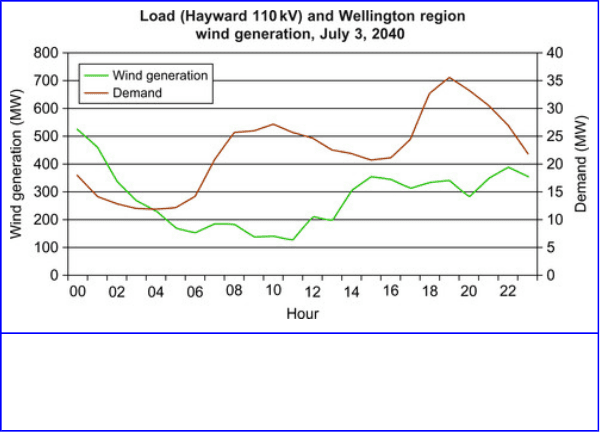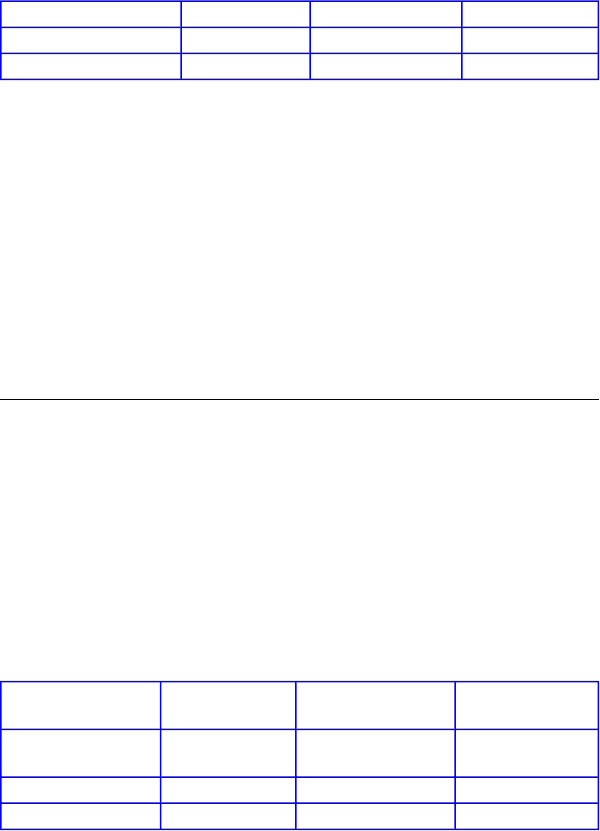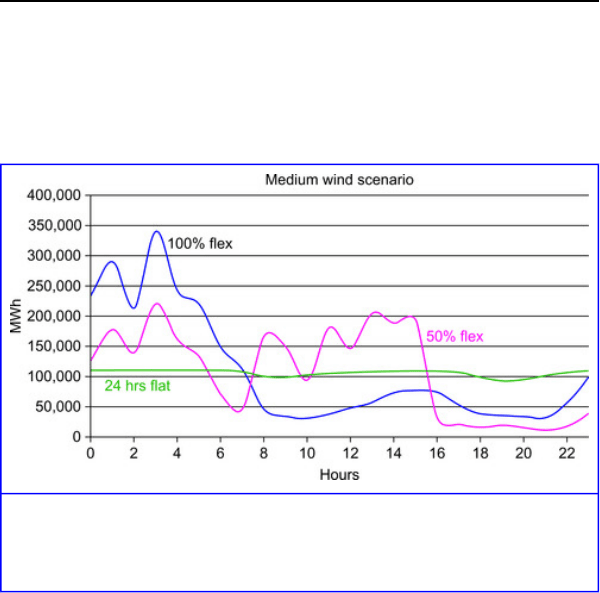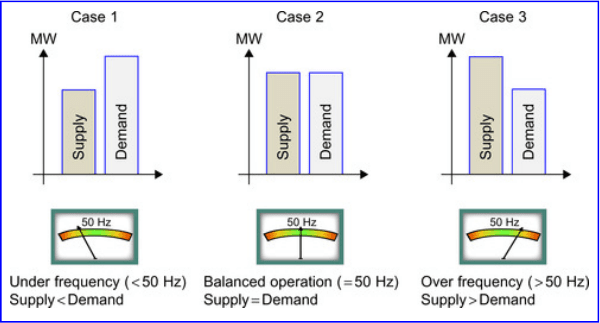Sioshansi F.P. Smart Grid: Integrating Renewable, Distributed & Efficient Energy
Подождите немного. Документ загружается.

ways. For this purpose three recharge schemes were
formulated to model a range of different behaviors:
• 100% flexible scheme: All EVs are assumed to charge at
the optimal time of day based on when the nodal price is
lowest. The price is typically lower during night but as
more and more wind capacity is added to the system, prices
may drop during daytime as well if wind generation is
high.
• 50% flexible scheme: Half the EV demand is fully
flexible as per above. The remaining half has to be
recharged between 8 AM and 4 PM, but will be timed
optimally within this period (again based on nodal price).
This models people recharging their EVs while at work.
• 24 hours flat scheme: The daily demand from EVs is
divided equally among each of the 24 hours, creating a
constant demand from recharging.
Overall, this spans from the best case—100% optimized
charging—to a case where charging occurs during any hour
of the day, including time of peak demand, for convenience
reasons. For the two flexible schemes, the recharging is
optimized based on the demand and wind output on a
day-to-day basis. In some cases, there will be plenty of wind
generation and in other cases almost none. The model did not
assume demand could be moved from one low-wind day to
another windier day.
It was assumed that all the EVs were plug-in hybrid cars,
which either could use electricity or gasoline as fuel. The
breakeven price for the vehicle owner is $NZ 315/MWh (in
wholesale prices) based on a long-term expected gas price of
$NZ 2/L.
14
When the nodal price is higher than the
881

breakeven price, gas will be used rather than electricity to
power the cars. This happens rarely, typically only during
severe constraints during winter peak demand or at times of
low hydro storage.
14
As per May 1, 2011, 1 NZ$ = 0.8 US$.
The following key aspects were examined under each
scenario:
• Interaction between wind generation and EV recharging;
• System costs impact;
• Cost of recharge;
• Time of recharge; and
• Deferral of generation, transmission, and distribution.
Interaction Between Wind Generation and EV
Recharging
The first part of the analysis looks into how the different
recharge schemes interact with wind generation and the
wholesale electricity price under the medium wind scenario.
To illustrate this, one particular day in 2040 was selected,
which had significant changes in wind output during the day
and a high demand, being in the middle of the New Zealand
winter.
15
Wellington was chosen as a location as it has a
significant local demand and several wind farms are planned
in the area, which has a world-class wind potential.
15
New Zealand is a winter-peaking system.
882

Figure 18.5 shows the forecasted load profile from one of the
Wellington 110-kV substations (Hayward) as well as total
modeled wind generation output for the Wellington region
that day. Prices are expected to be lower when the Wellington
regional net demand (demand less wind generation output) is
low. Prices for the day will be lower in the early hours and
higher at times of the morning and evening peaks.
Figure 18.5
Example of wind generation and demand data for one day in 2040.
Figure 18.6 contains three charts showing how recharging
differed for that particular day for the three recharge schemes
as well as the resulting impact on the market price for that
location.
883

Figure 18.6
Modeled EV recharge for July 3, 2040, for the three recharge schemes.
In general, it shows that the flexible charging schemes ensure
charging occurs in low price hours. Some of the other key
observations are:
1. Prices in all three cases generally behave as expected
based on the given demand and wind profiles as per the
discussion of Figure 18.5.
2. Enough EV demand is moved to the nighttime period
under the 100% flexible demand scheme (top chart) to lift
the power price slightly above the other cases. As shown
later in Table 18.3, it will not make it more expensive for
the EV owners compared to the other recharge schemes,
but it would lift the revenue for wind generators, making
investments in wind generation more attractive or less
reliant on subsidies, should that be needed to reach the
assumed penetration levels.
3. Prices generally increase at the time of the peak if parts
of the EV demand must be met at those hours. This is
clearly the case for the 24-hour flat recharge scheme
(bottom chart).
4. The cut-off price point for the plug-in cars is reached
during hours 18 and 19 for the 24-hour flat recharge
884

scheme (bottom chart) and results in EV demand not being
delivered. This simulates that rational plug-in hybrid car
owners would refuel with gasoline instead of electricity.
System Costs Impact
Having verified that the recharge schemes worked as intended
in the modeling, the total variable system cost for 2040
resulting from the modeling was calculated. This corresponds
to the combined cost of fuel, carbon emissions, and other
variable operational and maintenance costs associated with
the delivery of energy and the provision of instantaneous
reserve capacity that year.
16
The results are shown in Table
18.2. It can be seen that for less flexible recharge schemes the
costs are higher, as occasionally they require higher cost
peaking plants to provide the electricity needed to recharge
the EV fleet.
16
Capital costs are not considered here, so one cannot conclude that 25%
wind penetration is better overall for society than 5% or 15%.
Table 18.2
Total Variable System Costs for 2040
System Costs
($million)
Low Wind (5%
Penetration)
Medium Wind
(15% Penetration)
High Wind
(25%
Penetration)
No electric vehicles $1,601 $1,364 $1,198
100% flexible scheme $1,775 $1,487 $1,255
50% flexible scheme $1,799 $1,499 $1,283
24-hours flat scheme $1,827 $1,540 $1,303
System Costs (% of No
Electric Vehicles)
Low Wind (5%
Penetration)
Medium Wind
(15% Penetration)
High Wind
(25%
Penetration)
885

100% flexible scheme 110.8% 109.0% 104.7%
50% flexible scheme 112.3% 109.9% 107.1%
24-hours flat scheme 114.1% 112.9% 108.7%
The discussion around Figure 18.4 showed that adding EV
demand corresponds to a 4% increase in demand over the
base case without any EVs. Table 18.2 shows the percentage
increase in costs is higher than the 4% percentage increase in
demand. This is because the majority of the demand in the
no-EV case is met by renewables with no fuel costs (as per
Table 18.1), while any increase in demand above this is met
by fossil technologies with a significant fuel and carbon cost.
Cost of Recharging
The next part of the analysis looked into the costs of
recharging from an EV owner's perspective. Table 18.3 shows
that more wind lowers the average annual cost of recharging
the EVs. Also, the average cost is reduced if recharging is
flexible, so it can be optimized based on the wind generation
each day.
Table 18.3
Average Recharge Costs
Average Recharge
Costs ($/MWh)
Low Wind (5%
Penetration)
Medium Wind
(15% Penetration)
High Wind (25%
Penetration)
100% flexible
scheme
$65.12 $46.11 $21.25
50% flexible scheme $74.01 $50.71 $31.75
24-hours flat scheme $84.52 $65.87 $39.17
Comparing the three charts in Figure 18.6 illustrated that
flexible charging could lift prices in off-peak hours, but this
table shows that the benefits from not charging in more
886

expensive peak hours more than counter the increased costs
off-peak. As indicated, investors in wind generation will
benefit from this increase in price though, as it typically
coincides with times with high wind generation. Overall,
there are synergies between wind power and flexible
recharged EVs.
Time of Recharge
The time at which EVs are recharged is a critical factor in
reducing market costs, as Figure 18.7 shows when the model
decided to recharge the EV demand over the full year for the
medium wind scenario.
Figure 18.7
EV charging times.
The daily profile demand on the New Zealand power system
is generally similar to the demand profile shown in Figure
18.5. Demand tends to peak in the morning (hours 8–10) and
887
in the evening (hours 18–20). The 100% flexible scheme
predominantly recharges during nighttime but also between
the morning and evening peaks. The 50% flexible scheme
must recharge half during work hours, and the rest is mainly
nighttime recharge. The 24-hour flat scheme draws power
uniformly over the course of the day unless the price of
electricity exceeds the breakeven price, which can be seen in
the slight reductions in power drawn between hours 8–10 and
hours 18–20.
The key observation is that even in the flexible cases the
model finds it optimal to recharge sometimes during the
evening peak.
17
This will be driven by a combination of
localized high wind generation and transmission constraints
limiting export capability from those locations. While this is
optimal from a transmission point of view, no consideration
has been given to distribution network capability, which may
require significant upgrades if recharging is happening during
peak hours.
17
Similar behavior is observed for the other wind scenarios, though there is
a tendency that higher wind penetration levels cause the model to
recharge during the evening peak more often.
Improving System Reliability by Plugged-In EVs
This section will describe how EVs can help improve system
reliability or maintain reliability at lower costs, including
reliability issues related to increased wind power penetration.
The key to this is the use of DDC for controlling when and
how quickly plugged-in EVs are recharged.
18
DDC
technology has been given much less attention than smart
meters and other smart grid technologies so it will be
explained in more detail in this section.
888

18
Vehicle-to-grid (V2G) operation, where power is sent from a fully or
partly charged battery back to the grid, is not considered. Only the speed
of recharging is altered.
In comparison with the typical smart grid technologies, DDC
is based on a simple concept, which has been around for a
long time. As will be seen, it is potentially a very powerful
addition to how to operate the power system; either as a
means of improving reliability or providing the same level of
reliability at lower costs. In DDC, the information to control
the system is contained in the actual frequency that the grid is
operating at. This is illustrated in Figure 18.8 assuming a
50-Hz system.
19
It is based on the fact that the “system
health” is signaled by the frequency. If the frequency is below
50 Hz, demand is exceeding generation (case 1), and if the
frequency is above 50 Hz, generation is exceeding demand
(case 3).
19
Other systems uses 60 Hz, but for ease of explaining, 50 Hz has been
assumed in the following.
889

Figure 18.8
Power system frequency as an indicator of system health.
Frequency has to be kept close to 50 Hz (case 2) at any time
to prevent damage to electrical equipment and potentially
blackouts. During normal operation, generation is adjusted
continuously to match changes in demand throughout the day.
However, during abnormal system conditions caused by
outages, large changes can happen very quickly
• Outage of large generator: leads to frequency dropping
• Outage of major industrial load: leads to frequency
increasing
• Outage of transmission line: leads to frequency dropping
in the receiving end while frequency increases in the
sending end
Frequency drops are most critical, as it takes time to start up
generators to cover the loss of generation or transmission.
Frequency Fluctuations in New Zealand
The New Zealand power system experiences large frequency
fluctuations compared to large continental power systems.
This is due to the lower inertia of the power system and the
size of experienced disturbances. Frequency is managed
within a normal target band of 49.8 Hz to 50.2 Hz, which is a
large range compared to frequency variations on a continental
power grid. Figure 18.9 shows the variation in frequency for
the North Island and South Island power systems over a
period of 50 minutes in the early hours of December 16,
890
